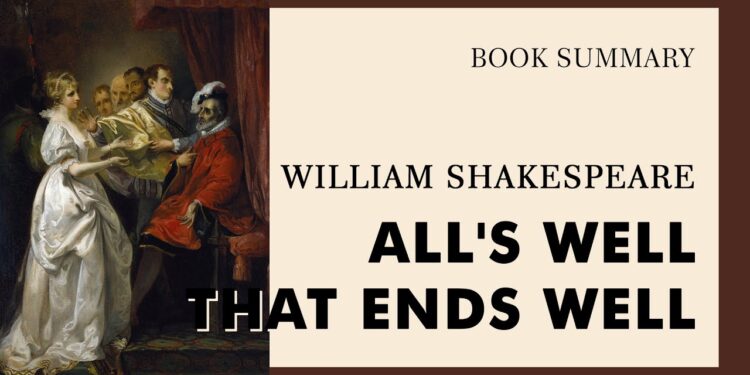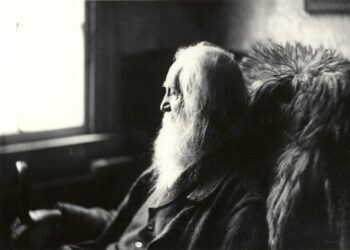Table of Contents
ToggleIntroduction
All’s Well That Ends Well Summary By William Shakespeare one of William Shakespeare’s later comedies, is a play that combines romance, wit, and social commentary, all while exploring complex themes such as love, marriage, and personal integrity. First published in the early 17th century, the play presents a narrative filled with twists, misunderstandings, and a profound commentary on the nature of human relationships. The title itself serves as an ironic reminder that, while the ending may appear happy, the journey to get there is filled with manipulation, deceit, and societal barriers.All’s Well That Ends Well Summary And Themes By William Shakespeare
At the heart of the play lies Helena, the daughter of a deceased physician, who embarks on a bold and unconventional journey to win the heart of Bertram, a nobleman who initially rejects her. The complex nature of the characters and their relationships creates a rich tapestry of themes including the nature of love, the societal expectations of women, and the moral questions that surround personal ambition and social hierarchy.All’s Well That Ends Well Summary And Themes By William Shakespeare
Summary of All’s Well That Ends Well
Act 1: The Setup
The play begins with the introduction of Helena, the daughter of a renowned but deceased physician. Helena lives with the Countess of Rossillion, a noblewoman who is a close friend of her late father. Helena is in love with Bertram, the Count’s son, who, despite his nobility and status, is not interested in her. Bertram, as the young nobleman, is focused on his social ascent and is not inclined toward a marriage to someone of Helena’s status. Despite this, Helena remains devoted to him.All’s Well That Ends Well Summary And Themes By William Shakespeare

When the King of France falls ill, Helena seizes the opportunity to prove her worth. She decides to use the medical knowledge she inherited from her father and heals the king with a secret remedy. In gratitude for her skill and dedication, the king grants her a wish. Helena, ever determined, asks for Bertram’s hand in marriage, an outcome that surprises everyone. Bertram, however, is reluctant to marry her, as he still believes her to be beneath him in social rank.All’s Well That Ends Well Summary And Themes By William Shakespeare
Read more
Act 2: The Conflict Unfolds
Despite Bertram’s reluctance, the marriage is arranged, and the young couple is married. However, Bertram quickly leaves for the military, rejecting Helena and leaving her in a state of deep emotional turmoil. Bertram makes it clear that he will not consummate the marriage unless Helena can fulfill two impossible conditions: he demands that she bring him his family’s ring and become pregnant with his child.All’s Well That Ends Well Summary And Themes By William Shakespeare
Helena, undeterred by Bertram’s disdain, sets out to win his heart through a series of bold and cunning actions. She seeks the help of Parolles, a soldier and a companion of Bertram, who is known for his arrogance and deceitfulness. Parolles is easily tricked by Helena into revealing the plans of the men in Bertram’s camp, and Helena uses this knowledge to her advantage.All’s Well That Ends Well Summary And Themes By William Shakespeare
Act 3: The Resolution of the Conflict
Helena arrives in the camp where Bertram is stationed and, through a clever series of schemes, manages to fulfill both of his conditions. She tricks Bertram into giving her the family ring, and through a series of disguises and deceptions, she manages to convince him that she is pregnant with his child.All’s Well That Ends Well Summary And Themes By William Shakespeare
In the final moments of the play, Bertram is confronted with the reality of his actions. He begins to realize that Helena is not the weak, inferior woman he once believed her to be, but rather a clever, determined, and capable individual. Eventually, Bertram accepts her as his wife, and the couple is reconciled. The play ends with a sense of resolution, though the events leading up to it raise significant questions about the nature of love, marriage, and the roles of women in society.
Themes in All’s Well That Ends Well
1. The Nature of Love and Marriage
One of the central themes of All’s Well That Ends Well is the exploration of love and marriage. The play presents a relationship that is founded on external forces—Helena’s manipulation of the king’s gratitude and Bertram’s forced compliance—but also examines how love can grow in unexpected ways.All’s Well That Ends Well Summary And Themes By William Shakespeare
Helena’s perseverance and intelligence demonstrate that love is not simply a matter of passion or status, but rather can be a product of inner strength and determination. Conversely, Bertram’s initial reluctance and disdain highlight the complexities of love, especially when it is seen through the lens of social hierarchy.All’s Well That Ends Well Summary And Themes By William Shakespeare
The play poses questions about whether love can be forced or manipulated, and whether marriage based on social and familial obligations can ever lead to true happiness. In many ways, the ending—where Helena and Bertram come together—suggests that while external factors may have brought them together, true love may eventually emerge from these circumstances.All’s Well That Ends Well Summary And Themes By William Shakespeare
2. Social Status and Class
Class and social status play a significant role in shaping the characters’ interactions and the conflicts that arise throughout the play. Helena’s status as a lower-born woman creates a significant barrier to her marriage with Bertram, despite her noble qualities and accomplishments. Bertram’s initial rejection of her stems from her perceived lack of social standing, and even the king’s grant of her wish cannot change the fact that social status dictates much of their interactions.
The play critiques these rigid social hierarchies, showing how they restrict personal choice and true love. Helena’s cleverness, resourcefulness, and determination to achieve her goal—despite the social constraints placed on her—serve as a subtle critique of the classist structures of the time.

3. Deception and Trickery
Deception plays a key role in All’s Well That Ends Well, with multiple characters engaging in subterfuge to achieve their ends. Helena’s actions throughout the play—particularly in the ways she tricks Bertram into giving her the ring and believing that she is pregnant—underscore the play’s exploration of the ethical implications of trickery.
All’s Well That Ends Well Summary By William Shakespeare While Helena’s manipulation of Bertram and others may seem morally dubious, it is also presented as a form of agency in a world where women have limited power. Through her use of intelligence and cunning, Helena is able to defy the social limitations placed on her and achieve her desired outcome.All’s Well That Ends Well Summary And Themes By William Shakespeare
Read more
4. Masculinity and Honor
All’s Well That Ends Well Summary By William Shakespeare The play also explores the themes of masculinity and honor, particularly through the character of Bertram. His sense of honor is tied to his social status and his ability to fulfill traditional expectations of masculinity—such as military prowess, sexual conquest, and the pursuit of personal glory. Bertram’s reluctance to accept Helena’s love and his treatment of her are tied to his belief in a rigid code of masculinity that does not allow for emotional vulnerability or deviation from social norms.
The character of Parolles, who is portrayed as cowardly, deceitful, and obsessed with maintaining an image of bravery and honor, further explores these ideas. In the end, the play suggests that true masculinity may be found in humility, self-awareness, and the ability to adapt to love and emotional connection, rather than in superficial displays of power or pride.All’s Well That Ends Well Summary And Themes By William Shakespeare
5. Gender and Power
Helena’s journey throughout the play highlights the tension between gender expectations and the quest for personal agency. As a woman in a male-dominated society, she is expected to remain passive and obedient, particularly in matters of love and marriage. However, Helena defies these expectations by taking matters into her own hands, using her intelligence and cunning to navigate the complex and oppressive social structures that stand in the way of her desires.All’s Well That Ends Well Summary And Themes By William Shakespeare
The play raises important questions about gender dynamics, as Helena challenges traditional notions of femininity. Her success is not based on her beauty or charm, but on her intellect, resourcefulness, and resilience. Through Helena’s actions, the play critiques the way women’s power is often marginalized, and it suggests that women have the ability to shape their own destinies, even within restrictive societal norms.
Conclusion
All’s Well That Ends Well Summary By William Shakespeare All’s Well That Ends Well is a play that challenges societal norms and expectations, particularly with respect to love, marriage, and gender. Through the character of Helena, Shakespeare explores themes of perseverance, intelligence, and personal agency, while also critiquing the rigid social hierarchies and notions of masculinity that dominate the play’s world.All’s Well That Ends Well Summary And Themes By William Shakespeare
The play’s complex blend of comedy, romance, and moral ambiguity makes it one of Shakespeare’s most intriguing works, offering a rich commentary on human relationships and societal values. While the title promises a happy conclusion, the journey to that resolution is fraught with tension, deception, and deep philosophical questions about love and social convention.All’s Well That Ends Well Summary And Themes By William Shakespeare
Read more
FAQ
1. What is the significance of the play’s title?
The title All’s Well That Ends Well suggests a conclusion that ties up all loose ends, implying that despite the complexities and challenges in the play, the resolution is satisfactory. However, the title is also somewhat ironic, as the journey to the play’s conclusion is marked by manipulation, trickery, and moral ambiguity, challenging the idea that “all is well” by the end.
2. What does Helena represent in the play?
Helena represents the idea of inner strength, resourcefulness, and perseverance. Despite being from a lower social class, she uses her intellect and determination to overcome the obstacles placed in her way. She challenges traditional gender roles and societal expectations, demonstrating that true love and personal agency can transcend social boundaries.
3. How is Bertram portrayed in the play?
Bertram is portrayed as a young man who is initially resistant to the idea of love and marriage, especially with someone of a lower social status like Helena. He embodies a rigid sense of masculinity and honor, but his character evolves as he is forced to confront his own pride and arrogance. By the end of the play, Bertram undergoes a transformation, recognizing Helena’s worth and ultimately accepting her as his wife.
4. What role does Parolles play in the narrative?
Parolles serves as a comedic foil to the more serious aspects of the play. He is a boastful and self-absorbed character who pretends to be brave and honorable but is revealed to be a coward and a fraud. His character provides a critique of superficial notions of masculinity and honor, highlighting the emptiness of empty bravado.All’s Well That Ends Well Summary And Themes By William Shakespeare
5. Is All’s Well That Ends Well a comedy?
While All’s Well That Ends Well contains many elements of comedy, including mistaken identities, humorous characters, and witty dialogue, it also deals with more serious and complex themes such as love, marriage, social status, and deception. Some critics have classified it as a “problem play” due to the moral ambiguities and darker elements that underlie its comedic surface.All’s Well That Ends Well Summary And Themes By William Shakespeare
Read more

















